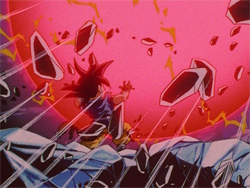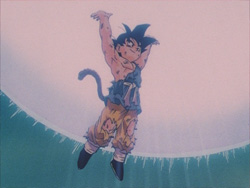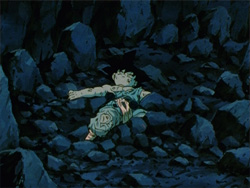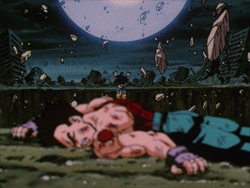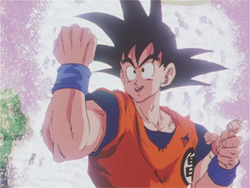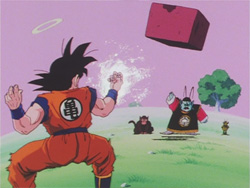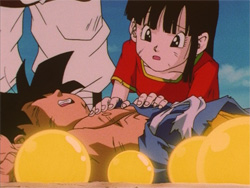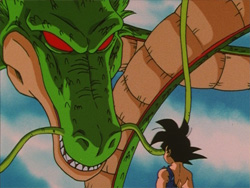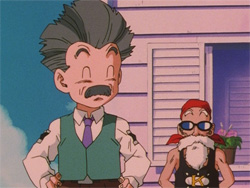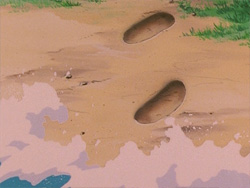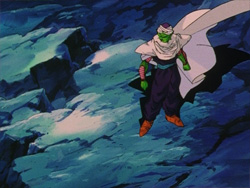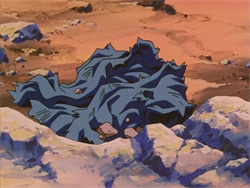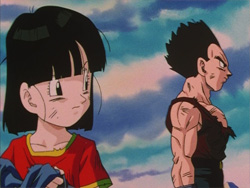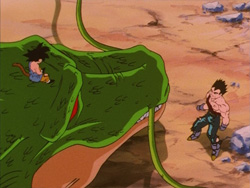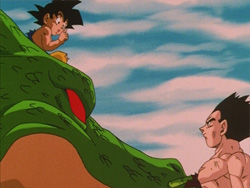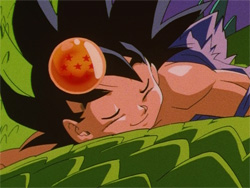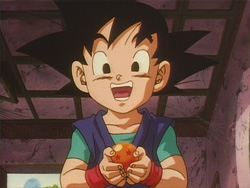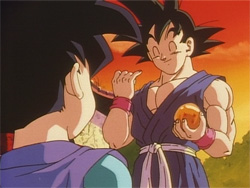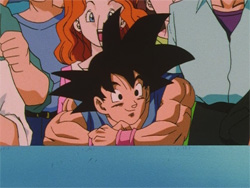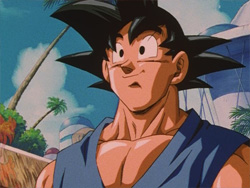Ever since its original airing in 1997, one of the biggest fandom discussions has revolved around what actually happens to Goku at the very end of Dragon Ball GT. Does he die? Where did he go? What did he become? What is its significance? Is there something I am missing? If you have seen the episode, you know that very little is actually answered, which is probably why the discussion rages to this very day.
The purpose of this page is not to concretely answer any of these questions, but rather to provide some guidance into our own thought process as fans. We hope this does not completely influence you in any particular way, but rather opens up several other avenues for you to travel down, reaching your own conclusion.
When we really break down the discussions, we come to two questions:
(1) Did Goku die?
(2) Where did Goku go? or What did Goku become?
Point No. 1: Did Goku Die? If So, When?
Let us first tackle the question of whether Goku died. Ignoring any evidence just yet, if you subscribe to the idea that Goku died, it could have been at one of two points:
In order to make any progress, we need to examine these two instances of possible death.
There is a possibility that Goku died in the process of blocking Yi Xing Long‘s attack. Goku simply lies down there unmoving, and as far as everyone else is concerned, he is dead. Vegeta even takes it upon himself to continue the fight, seemingly asking for Goku’s spiritual help in the process. Of course, he gets impaled and shocked with Yi Xing Long‘s Dragon Thunder, getting thrown over to the same crater, where he sees Goku down below, smirks with a snarky remark, and passes out.
However, there is a good deal of evidence to the contrary. He appears to be both verbally and physically interacting with his companions and his surroundings after he rises up with the Genki-Dama. His conversations with and through Kaiō-sama seem to be pretty on-the-ball; nothing is any more or less out of the ordinary from other times we have seen this type of situation take place. Even Goku simply rising out of the crater — with a Genki-Dama no less — seems to imply that he simply took a beating.
How about Goku’s use of the Genki-Dama? Can a dead person even use the technique in the first place? The only instance we have seen to support this is Goku’s original training on Kaiō-sama‘s planet. He was still dead at this time and mastered both the Kaiō-Ken and the Genki-Dama. While this proves that a dead person could, in principle, actually collect the living energy necessary to create the Genki-Dama, it does not disprove Goku being alive, either.
While there is not much solid evidence to further discuss the “death before Genki-Dama” theory, there is an enormous amount to discuss regarding a death during or immediately after the final attack. Goku’s conversations and interactions in the process of forming the attack seem pretty normal, but everything that takes place afterward is extremely suspect.
Goku does not, at any point, showcase a halo. Unfortunately, this is another item that does not prove anything any which way. It could be that dead bodies that remain on Earth simply do not get a halo (only showcasing this once they arrive in the afterlife); it could be a desire by the animators and writers to keep things vague… it could be any number of things.
Notice, however, Shenlong’s self-summoning at the end of Episode 63. In addition to this, his eyes glow. This action typically indicates a wish has been granted. What wish was granted, though? Was Goku brought back to life, or was he simply healed back to full-strength? We have seen both of these wishes granted before, and both to Goku himself. This eye-glowing was reiterated at the beginning of Episode 64; it could simply have been a stylistic decision, or it could actually mean something. The same thing goes for Goku’s body glowing; it could be that he was brought back to life or healed to full strength, or perhaps it was just done for the hell of it. Again, we do not know the inner workings of the writers’ minds aside from a few comments in guidebooks over the years (see below), so for us viewers, it is nothing more than vague evidence. Perhaps it is nothing more than laziness; it would not be the first time that Toei staff members forget simple facts and create inconsistencies in the Dragon Ball GT storyline. On the other hand, maybe the writers created an intentional sense of mystery just for the sake of mystery by combining all of these elements. Neon Genesis Evangelion does this perfectly, tossing in symbolism that would otherwise appear relevant if one did not know that they did it just for the sake of doing it. That is not to compare the writing in Evangelion to Dragon Ball, but it is certainly a possibility.
What does Shenlong have to gain by summoning himself? Has he come just to reprimand everyone? If you pay attention to his interactions with Goku, you will notice some type of unstated understanding between them. After Goku makes the wish for everyone killed in the last round of fighting to be brought back to life (which could still happen even if Shenlong granted a wish to bring Goku back to life, since Shenlong can grant multiple wishes), Goku seems to know that it is time to leave.
SHENLONG: “Your wish is granted. Come, let us go, Goku.”
GOKU: “Huh? Is it that time already?”
Leave for where and with whom? Goku seems to know exactly what Shenlong is talking about, however. How, exactly, is there already some type of understanding between the two? We have not seen them discuss anything, so any conversation and mutual understanding would have to have taken place during the time that Goku was dead or unconscious after the Genki-Dama destroys Yi Xing Long. Perhaps while he was dead, Goku made some type of deal or spoke to someone so he could come back and say his goodbyes? In addition to all this speculation, we have to take another look at that wish; did Goku somehow trade his own life or soul for the Dragon Balls to be able to return at some point in time, or even just to bring all those people back to life?
That is where the next big piece of evidence comes in, with Goku’s goodbyes to various friends and family. In Goku’s conversation with Kuririn and Kame-Sen’nin (and Umigame, as well), notice how Kame-Sen’nin’s gaze never once lifts from Goku out on the beach. Kuririn does their little sparring and closes his eyes with a smile as he yaps on, but Kame-Sen’nin stands there with no change in his expression. This is also the first instance of the “Goku… are you…?” line uttered by someone this episode.
A similar situation takes place down in Hell with Piccolo. Piccolo immediately notices that something is strange about the entire situation (after getting over his initial frustration that Goku is even down there after he went to such lengths to get him out during the Super 17 fight). Piccolo’s response upon turning around to see Goku gone is extremely similar to Kame-Sen’nin; he does not seem to make any additional remarks or show of emotion, seemingly understanding the situation.
Back at the “scene of the crime”, so to speak, Pan knows something is up when she sees Goku’s torn-up gi lying on the ground… which he was wearing when he left with Shenlong. Goku Jr. also wears this same gi (in its entirety, even if it is slightly torn up) at the end of the episode, a century later. If this is the case, Goku could not have both taken off wearing it and also left it behind. It is not as if you can clone clothing, either (except for Namekians, anyway). Vegeta’s line to Pan also underscores the whole scene: “Make sure you hold that dear.”
Vegeta is an interesting case here, since up until this point, he seems to be the only one at the scene that appears to know what is occurring. While he initially thinks that Goku is simply off to train somewhere, we get that same half-sentence muttering of understanding, to which Goku responds with a “hush” finger to his lips and a goodbye.
VEGETA: “Hold it, Kakarrot! Are you training again?… (gasp)… Kakarrot, are you…?”
GOKU: “(inaudible hush)… See you later, Vegeta.”
As Goku leaves with Shenlong (having said all of his goodbyes), the Dragon Balls become absorbed into his body. Trunks notes that they are being tested (since Shenlong is taking the Dragon Balls away from them), and that when the time is right and the balance of the world has been restored, the Dragon Balls will once again reappear for a new generation. Sure enough, Goku Jr. finds the now-activated Four-Star Ball sitting in the shrine by the Son family home on Mount Pao-tzu.
Have the Dragon Balls returned? If so, what was the significance of Goku absorbing them 100 years earlier? Was Goku some type of “vessel” for those years? Did he become some type of “god” or other “guardian” of the Dragon Balls? Did he die, though? Perhaps Goku realizes that he (in conjunction with the Dragon Balls) is nothing more than a magnet for evil, and that by departing with them, he will somehow restore equilibrium to the world.
In addition to Goku’s role, it is also interesting to take a look at the way he is portrayed.
Point #2: Goku in the Dragon Ball GT Television Special
In the Dragon Ball GT television special — which aired 26 March 1997, roughly seven months before the end of the series — Goku appears as an adult to Goku Jr. Does Goku choose to appear this way, or has the spell cast upon him at the very beginning of DBGT worn off? Maybe he naturally grew-up again after the one hundred years? Goku’s ghostly “thumbs-up” to Goku Jr., along with his image up in the sky at the end of the TV special (and his flying off with Kinto-Un and Nyoi-Bō at the very end of episode sixty-four) pretty heavily implies something; what that “something” is happens to be a mystery that we are attempting to solve!
What is interesting to note, however, is that the TV special actually aired after episode forty-one of the series (on 26 March 1997, between some minor one- and two-week-long breaks in the series’ airing); the rest of these events would not take place until episode sixty-four. As these events were set up so much earlier via the TV special, did the writers simply not know how or when they were going to get to that point? It is no secret that preproduction on a new adaptation Dr. Slump (Dragon Ball creator Akira Toriyama’s first hit series) was already underway by the final arc of Dragon Ball GT, and the rushed feel of the rest of the series suggests the story had to be condensed into the limited number of episodes left before the new Dr. Slump made its debut.
Both here in the TV special and again at the end of episode sixty-four, Goku appears to be indirectly overseeing things (“watching from above”, if you will). It is unlikely that he has taken on the role of “God” (Dende was pretty young when he took over, and did not seem to be going anywhere any time soon; the Namekian should live for quite some time). In each of these cases, Goku appears and disappears just as quickly (this even happens back when he says his goodbyes to everyone).
While this does not necessarily mean anything other than that Goku can move extremely fast, the way in which he disappears is always made to be somehow mystical in nature. Kuririn laughs; Goku is gone. Piccolo turns around; Goku is gone. Goku Jr. turns around to see the plane; Goku is gone. Pan sees him across the ring, but by the time she gets over there he is gone, yet again.
So we must ask again… Did Goku die? What did he become? Where did he go? In the end, these questions are not actually answered by the show, and we are left to our own thoughts. If anything, the end of Dragon Ball GT certainly provides more to discuss than Toriyama’s original ending from the manga, and it may be that wondrous sense of finality and closure (as opposed to Goku flying off with some random kid) that the writers were going for and managed to accomplish.
Point #3: Production and Staff Comments
In a story-focused Q&A session in 2005’s Dragon Ball GT Dragon Box DVD release, script writer Atsushi Maekwawa explicitly details their intent to keep things vague, while offering some personal thoughts and commentary of his own:
To be honest, in GT episode 63, just before the final episode, a big change comes over Goku. Those who watched carefully might have noticed, but… In that episode, Goku, who takes Yi Xing Long‘s attack, sinks to the bottom of a deep hole. That is the turning point. Afterward, Goku still continues the battle, but what’s different from before is that he’s cloaked in an aura that won’t let any attack near him.
It might be that he died there, or it might be that he became something else entirely. I’ll leave that decision to the imaginations of everyone who watched. However, the Goku up to that point that everyone knows clearly does not appear after that.
In the world of Dragon Ball, Goku had already died multiple times, and up till then, each time he appeared with a halo over his head. However, I didn’t want to go with the usual concept of, “even when he dies, he comes right back to life”. I wanted the viewers to picture “death” in that way, and feel a sadness close to it in reality. So I had a “change” come over Goku.
And then after that, once he defeats Yi Xing Long and grants the final wish, Goku goes right off with Shenlong and the Dragon Balls, to somewhere that people definitely can’t get to. While wishing that people will be able to get by on their own strength in a world without the Dragon Balls. And Vegeta is the only one who notices where he’s headed.
Except, I personally go ahead and imagine… that Goku might unexpectedly show up, just at Chi-Chi’s, from time to time. Yes, unexpectedly….
In an interview within the same DVD set booklet, producer Kōzō Morishita shares his own thoughts on the final scene:
With that last scene, right from when Dragon Ball GT began we had decided “let’s do it like this!” Not knowing whether he’s alive or dead, that sort of image. It was precisely because that scene had already been decided upon that we were able to have Goku make his impressive appearance at the end of the TV special “Goku’s Side Story! The Proof of his Courage is the Four-Star Ball”. Since the TV special was an original story, it required far more manpower, labor, and money than simply airing two regular TV episodes in an hourlong timeslot, but even in that regard Dragon Ball GT gave us a free hand to work with. I’m truly grateful for it; the Dragon Ball series is my precious treasure!
As one final bit of analysis, consider a bit of commentary from someone more closely associated with Son Goku than anyone else: voice actress Masako Nozawa. Within her interview in the second Dragon Ball GT Perfect File guide book, regarding the recording of the final episode, she notes:
The scene where, after Goku finishes fighting, he rides on Shenlong, and says, “Shenlong’s back sure is warm…”. That’s because riding on Shenlong means that Goku’s going to leave this world, and go to the world of the gods…. I was glad that they didn’t write it plainly that he died, though…. I feel that Goku probably went to Shenlong’s place, and is training again.

